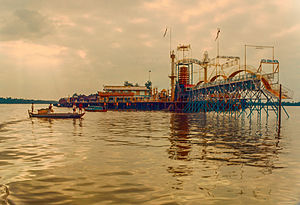Coconut Religion
The Coconut Religion (Vietnamese: Đạo Dừa or Hòa đồng Tôn giáo)[1] was a Vietnamese religious sect centered in southern Vietnam's Bến Tre Province. Founded in 1963, adherents created a "Coconut Kingdom" on an islet of the Mekong River. The religion is largely based on Buddhist and Christian beliefs, alongside the pacifism teachings of founder Nguyễn Thành Nam. The religion was abolished by the communist authorities after 1975. At its peak, the religion had some 4,000 followers. After the founder’s death following a clash with the authorities in 1990,[citation needed] the cult is now practiced by a very small minority.
Practice
The Coconut Religion advocates consuming only coconuts and drinking only coconut milk.[2]
History
The Coconut Religion was founded in 1963 by Vietnamese scholar Nguyễn Thành Nam,[2] also known as the Coconut Monk,[3][4] His Coconutship,[5] Prophet of Concord,[5] and Uncle Hai[5] (1909 – 1990[1]). Nam, who attended a French university,[2] established a floating pagoda[5] in the southern Vietnamese "Coconut Kingdom", in the province of Bến Tre.[2] It is alleged that Nam consumed only coconuts for three years;[1] for that period he also practiced meditation on a small pavement made from stone.[6] Nam was a candidate for the 1971 South Vietnamese presidential election; he lost and returned to his "Coconut Kingdom".[2] Despite his eccentric behaviour, the government of Saigon respected him and called Nam a "man of religion".[7] He usually sported a crucifix around his neck and dressed in traditional Buddhist robes.[8]
Estimates of followers of the religion worldwide were 4,000 at its highest. One notable follower was John Steinbeck IV, the son of American novelist John Steinbeck.[2] The religion was deemed a "cult" and was promptly banned in 1975 by communist officials.[2]
The Coconut Monk died in unexplained circumstances in 1990,[9] marking the demise of the cult.[citation needed] The Coconut Estate is now served as a tourist attraction along the My Tho Mekong Delta Tour.[clarification needed]
See also
References
- ^ a b c Dodd, Jan (2003). The Rough guide to Vietnam (4 ed.). Rough Guides. p. 142. ISBN 9781843530954.
- ^ a b c d e f g "Coconut religion". Vinhthong. Archived from the original on October 22, 2013. Retrieved May 25, 2013.
- ^ Pillow, Tracy (2004). Bringing Our Angel Home. iUniverse. p. 106. ISBN 9781469714011.
- ^ Ehrhart, William Daniel (1987). Going back: an ex-marine returns to Vietnam. McFarland. ISBN 9780899502786.
- ^ a b c d Vu Trinh (1974). "The Coconut Monk". Vietspring. Archived from the original on 2013-05-01. Retrieved 2013-05-26.
- ^ Hoskin, John; Howland, Carol (2006). Vietnam (4 ed.). New Holland Publishers. p. 115. ISBN 9781845375515.
- ^ Ellithorpe, Harold (1970). "South Vietnam: The Coconut Monk". Far Eastern Economic Review. p. 15.
- ^ "THE OTHER SIDE OF EDEN: LIFE WITH JOHN STEINBECK". American Buddha. Archived from the original on June 24, 2013. Retrieved May 26, 2013.
- ^ Laurance, Robin (2019-07-01). Coconut: How the Shy Fruit Shaped our World. History Press. ISBN 978-0-7509-9273-2.
- Articles with short description
- Short description with empty Wikidata description
- All articles with unsourced statements
- Articles with unsourced statements from March 2022
- Commons category link is the pagename
- AC with 0 elements
- Religion in Vietnam
- Buddhist new religious movements
- 1963 establishments in South Vietnam
- Religious organizations established in 1963
- Religious organizations disestablished in 1975
- Organizations disestablished in 1975
- 1963 in religion
- 1975 disestablishments in Vietnam
- Religious syncretism in Vietnam
- Coconuts

